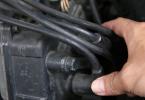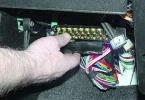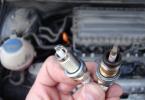Repair and painting of plastic parts of the car occurs more often than painting metal body elements. At the same time painting the plastic of the car with their own hands is not so complicated procedure, so it can be done even in its own garage. You can paint yourself as plastic salon and outer plastic, for example,.
For painting plastic, special materials will be needed. Paint should be applied to a properly prepared surface of plastic, otherwise time, money and materials will be spent in vain. First you need to determine the quality of the plastic to know - whether it will be necessary to primitive when pre-prepared or not.
As a rule, two types of plastic are used in cars. To check which one will require primer, and which is not, you can use two simple ways. The first is to dip plastic into the water (suitable if the item must not be repaired, but only to paint). The meaning is: if plastic floats - it is necessary to primitive if drowned - you can do without primer.
The second method is suitable more for details that need to be repaired before painting, or for large parts that are not placed in water container (for example, bumper). A piece of plastic need to set fire and blame the burning process. If the plastic smokes - the primer is not needed, if it burns with a uniform pure flame without a soot, then the primer is needed.
What to choose: can or brush?
Paint, primer or lacquer for plastic is sold both in the canopy and in banks. Brush is better to paint small curly parts from plastic, painting will be better than from the can, as the aerosol is very sprayed and does not always fall into hard-to-reach places.
The sequence of actions is as follows: The item is thoroughly cleaned from contaminants, degreases and processed by antistatic. Antistatic treatment is needed so that the plastic does not attract dust to itself and various small porcers that will spoil the type of paint.
Then the part is processed by sandpaper, and defects to be repaired are covered and grind out again. Sandage is better to use moisture resistant. It is necessary to lift irregularities, periodically wasting the place of squeaking with water, "all the small surface cracks will be eliminated. After such treatment, it is necessary to wait for it drying and again degreases, otherwise there may be traces of skin fat, and on a poorly low-fat surface, the paint will not hold well.
Further - for better adhesion paints with plastic. The primer must be applied in 2-3 thin layers. For parts of plastic, which does not require primer, this step can be skipped. If the part is repainted in another color, you can use color soil.
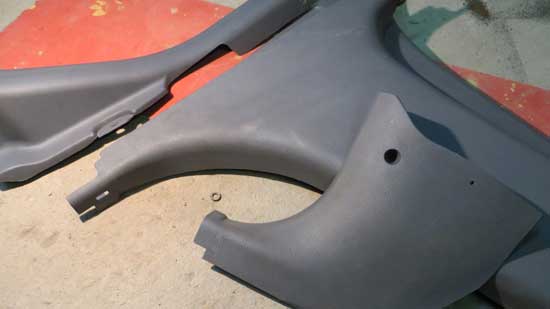
After drying the primer, acrylic paint using a spray or spray collar is applied to a uniform layer on the part. Apply it, as well as primer, in 2-3 layers. Each layer before applying the next should dry. If the paint contained metallic, then after 20-30 minutes after applying the last layer, it is necessary to apply lacquer, and after drying it to polish the part with wax paste.
Plastic car with your own hands using a brush on painting technology is no different from the above method. Just for this type of painting, materials are used with a longer drying period, which respectively delays the entire process. And if it is not enough to paint quickly, the paint will begin to be captured at the tassel, which is why the divorces will remain.
Painted plastic
Most of the plastic parts of the car's interior do not have a decorative coating - they are painted in mass. This means that how much to scold such details, they remain the same color as they were originally. Scratches, of course, are visible, because plastic is a rather soft material, but they do not face.
On a note
Remove scratches with plastic can be different ways. There are special solvents, optical polyters, thermal solutions, as well as grinding, putty and painting. If the target is only to get rid of scratches, it is better to first try all available cosmetic methods.
If the painting of plastic is made in the framework of the tuning project, then, as a rule, color changes. For example, gray or black plastic parts of the cabin and dashboard, paint in yellow or some other color. In this case, any scratches or scratches formed later will rush into the eyes, since dark plastic will immediately stick under them.
During the repair of plastic parts of the car, the paint color is chosen as close to the original. The plastic painted with such colors will behave in the same way as unpacked. That is, the scratch will appear, but the contrast color will not stick under the paint.
Independent painting
Any plastic parts in the car can be painted independently. But the most difficult things are with plastic bumpers. For their painting, it is necessary to choose color. If you can not find exactly the same paint in the cans, you will have to contact the specialists.
For self-painting bumpers, you must have:
- suitable garage;
- compressor;
- kraspopult;
- paintwork materials (primer, putty, paint, varnish, solvents).
The equipment is expensive and buy it only for one-time painting does not make sense. All this can be rented, but the experience for rent does not surrender. Or you need to constantly practicing, having your own equipment, or find a good painting workshop.
Painting plastic elements of the exterior and interior of the car, for which you do not need to pick up the paint exactly in the tone, can be performed using aerosol cans. And such work is under the power almost every motorist. For painting you need to remove the item, carefully clean it and degrease, after which you can apply paint or soil.
On a note
It should be borne in mind that paint from the cans (nitroemal) contains an aggressive solvent. If you pour too much such paint on plastic, then it can dissolve. All item, of course, will not soften, but the surface layer - can very well.
In order to avoid the dissolution of the plastic, you should either use a special soil, or put the paint with a spraying, waiting for the full evaporation of volatile substances after applying each layer. The first few layers will create a kind of soil that will not give an abundant paint layer to interact with plastic directly. Nevertheless, even in this case, the last layer should not be applied too fat.
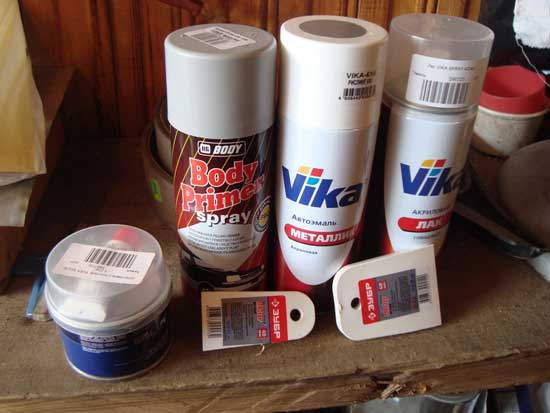
When painting plastic, an important factor is paint quality. It is no secret that today there are many fakes, and in the cans can be far from being written. There were cases when there was paint, which could dry for more than 10 hours and still remained a sticky. High-quality paint dries no more than 15 minutes, which allows you to paint plastic, without risk it dissolves.
In conclusion, I would like to inform about such an innovative method of decorative finishing of any materials, including plastic, as an aquail. The special texture film is applied to water, activated by a special substance and plunge into it the part. As a result, this item gets the top quality textural coating.
